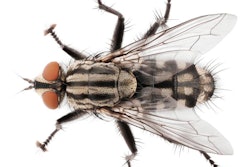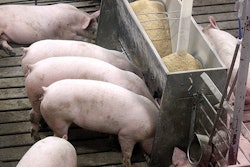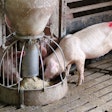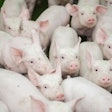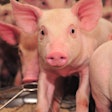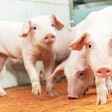
Supporting sow performance is key to ensuring herd productivity. Piglet weaning weights are an indicator of future growth, and improving colostrum quality supports health and performance. Colostrum is the first source of nutrition in neonatal mammals and mediates control of biological functions, including extensive immunological protection through immunoglobulins, as well as antimicrobial and anti-inflammatory agents. Colostrum also provides growth factors that control early gastrointestinal development.
What are fatty acids?
Medium- and short-chain fatty acids can be delivered to pigs via the diet, and are essential for optimal pig performance and health. However, they aren’t supplied by standard raw materials at optimal levels or ratios. Their targeted supplementation can convey a variety of benefits to the animal consuming them.
- Medium-chain fatty acids are involved, at the mitochondrial level, in oxidative metabolism. They have been shown to reduce gram-negative bacteria in the gut and capric acid monoglycerides demonstrate virucidal activity.
- Short-chain fatty acids are the preferred energy source of gut epithelial cells. They promote villi growth, improve absorption of nutrients and are involved in the apoptosis of damaged cells. Studies have observed that short-chain fatty acids inhibit Staphylococcus aureus induced TH1 cytokines IL-2 and IFN-ϒ, at the same time up-regulating TH2 cytokine IL-4 and anti-inflammatory IL-10 production.
parameters-of-sow-ration Sows fed the experimental ration weaned 0.4 more piglets, with a heavier weaning weight of approximately 0.5 kg compared with piglets from control sows, which carried through until they were 10 weeks.
New research
A mix of encapsulated short- and medium-chain fatty acids was fed to sows in a trial conducted at Queen’s University Belfast. The experimental diets were given in the last trimester of pregnancy and during lactation, and production parameters recorded. Sows fed the experimental ration weaned 0.4 more piglets, with a heavier weaning weight of approximately 0.5 kg compared with piglets from control sows, and this heavier weight was carried through until they were 10 weeks old.
immunoglobin-levels-in-sow-colostrum The inclusion of encapsulated fatty acids in sow rations increased the immunoglobulin levels in their colostrum.
In addition, IgG and IgM levels were significantly higher in the colostrum from sows fed the experimental ration. Newborn piglets are devoid of immunoglobulins and rely on the transfer from the mother via colostrum until they are able to synthesize their own. Twenty-four hours after birth, the piglet gut closes and they can no longer absorb IgG; therefore, it is important for the piglets to have access to high levels of IgG within the colostrum during the first few hours of life.
This transfer of immune protection is evident from analysis of piglet sera. Levels of IgG in sera, two and four weeks after birth, were significantly higher in the piglets of sows fed the experimental ration. This improved immunological status of the piglets is further supported by lower pre-weaning mortality.
The colostrum from sows fed the experimental diet also contained greater concentrations of fat and lactose. Increases in colostrum fat and lactose have been shown to improve piglet growth and development in the pre-weaning period. Fat is the main energy source for young piglets and lactose can be easily digested by the piglet’s immature gut.
differences-in-colostrum-value This graphic examines the differences in nutritional value of sow colostrum comparing an experimental versus a control ration.
Proteomics
Short- and medium-chain fatty acids did not come through in the sow’s milk. So, although they weren’t benefiting the piglets directly, increased weaning weights were observed.
In order to identify how the fatty acids were acting in the sow, a proteomic evaluation was carried out. Proteomics is the measure of the expression genes through proteins, showing which are up or down regulated. In this trial, five proteins were expressed differently in sows fed the experimental ration.
Three milk fat globule membrane proteins were down regulated: Perilipin-2, Xanthine oxidase and Butyrophilin sub family 1 A1. These proteins are responsible for the change in the membrane around the fat in milk; they break the membrane, reducing the amount of fat in the milk. Down regulation of these proteins means they are not as efficient at breaking the membranes of fat globules, so more fat stays in the milk.
In the study, higher levels of fat were found in the colostrum. Previous trials found that fat in colostrum and milk correlated positively with piglet weight gain and negatively with piglet deaths.
Both J chain and Immunoglobulin A heavy chain constant region were also unregulated. The J chain is essential for immunoglobulins A and M to be secreted into the mucosa, so they can carry out their protective role. These findings highlight the link between fatty acid consumption and the increase in colostrum immunoglobulins.
performance-parameters-for-sow-trail-with-fatty-acids An example of the average performance parameters for sows fed the experimental ration compared with the control.
Fatty acid evaluation
The effect of medium- and short-chain fatty acids on commercially produced pigs, on four units in Ireland was evaluated. Sows fed fatty acids had an improved average piglet birth weight, numbers born alive and mortality.
Across different commercial farms, there was a range of responses in pre-weaning mortality; farms with high pre-weaning mortality showed the largest reduction. Overall pre-weaning mortality was improved by 5 percent in those supplemented. Trials carried out over three years demonstrated that weaning weight tended to be higher when sows were fed fatty acids – by an average of 7 percent.
Early piglet performance is key to future herd productivity
While there are many economic measures, the number of piglets weaned per sow and their weaning weights are critical. If reproductive performance is improved from an average of 13 piglets weaned per sow to 13.5, there are several benefits to the producer. Dietary costs per pig are reduced – in terms of gestation and lactation diets. Piglets who weigh half a kilogram more at weaning go on to yield an extra three kilograms slaughter weight and would increase producer profits by GBP1.80 (US$2.30) per pig.
These estimations are based on feed costs alone, but if overhead costs are also considered, the economic advantage increases. If an average overhead cost is 30 pence per kilogram, an extra 0.5 piglets weaned per sow reduces the figure by GBP2 per pig. These calculations do not include further benefits in terms of the health and performance of the pig, including feed conversion ratio.
Implications for the economics of production
Peer reviewed research investigated the effect on long-term performance and survival, depending on the amount of colostrum a piglet consumes. It found that a piglet consuming no colostrum had a greater than 50 percent chance of dying. However, if it received at least 350 grams of colostrum, the chance of death before weaning was reduced to less than 10 percent. The researchers concluded that colostrum intake has a greater effect on weaning weight than birth weight.
By improving colostrum quality, this investigation with fatty acids strengthens the argument that colostrum is more important than birth weight. It showed that feeding fatty acids to sows during pregnancy and lactation has a positive effect the immunoglobulin profile and nutritional quality of colostrum, a benefit that was carried through to improved an immunological profile of piglet sera. Modern genetics and production techniques have led to increases in litter sizes, but this doesn’t always mean more piglets weaned or greater weaning weights.
Colostrum is vital and any nutritional strategy that increases its quality will pay producers dividends. If downstream production benefits in terms of greater pig performance and lower mortality are seen, then economics are improved.



